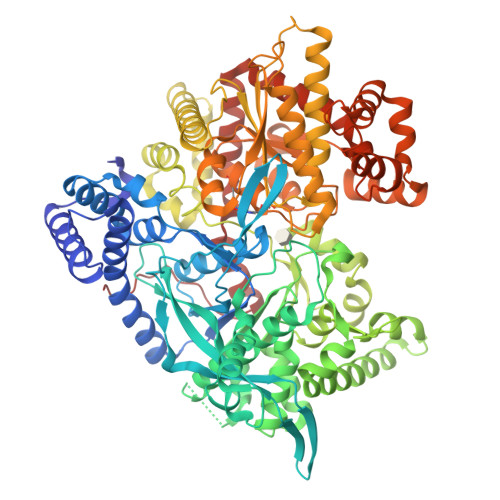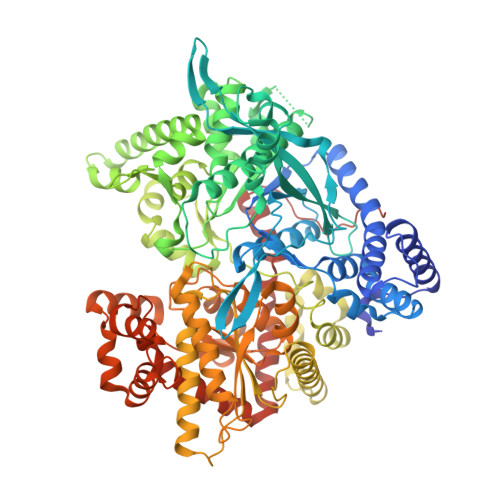Crystallographic studies on two bioisosteric analogues, N-acetyl-beta-d-glucopyranosylamine and N-trifluoroacetyl-beta-d-glucopyranosylamine, potent inhibitors of muscle glycogen phosphorylase
Anagnostou, E., Kosmopoulou, M.N., Chrysina, E.D., Leonidas, D.D., Hadjiloi, T., Tiraidis, C., Zographos, S.E., Gyorgydeak, Z., Somsak, L., Docsa, T., Gergely, P., Kolisis, F.N., Oikonomakos, N.G.(2006) Bioorg Med Chem 14: 181-189
- PubMed: 16213146
- DOI: https://doi.org/10.1016/j.bmc.2005.08.010
- Primary Citation of Related Structures:
1WW2, 1WW3 - PubMed Abstract:
Structure-based inhibitor design has led to the discovery of a number of potent inhibitors of glycogen phosphorylase b (GPb), N-acyl derivatives of beta-D-glucopyranosylamine, that bind at the catalytic site of the enzyme. The first good inhibitor in this class of compounds, N-acetyl-beta-D-glucopyranosylamine (NAG) (K(i) = 32 microM), has been previously characterized by biochemical, biological and crystallographic experiments at 2.3 angstroms resolution. Bioisosteric replacement of the acetyl group by trifluoroacetyl group resulted in an inhibitor, N-trifluoroacetyl-beta-D-glucopyranosylamine (NFAG), with a K(i) = 75 microM. To elucidate the structural basis of its reduced potency, we determined the ligand structure in complex with GPb at 1.8 angstroms resolution. To compare the binding mode of N-trifluoroacetyl derivative with that of the lead molecule, we also determined the structure of GPb-NAG complex at a higher resolution (1.9 angstroms). NFAG can be accommodated in the catalytic site of T-state GPb at approximately the same position as that of NAG and stabilize the T-state conformation of the 280 s loop by making several favourable contacts to Asn284 of this loop. The difference observed in the K(i) values of the two analogues can be interpreted in terms of subtle conformational changes of protein residues and shifts of water molecules in the vicinity of the catalytic site, variations in van der Waals interaction, and desolvation effects.
Organizational Affiliation:
Institute of Organic and Pharmaceutical Chemistry, The National Hellenic Research Foundation, 48, Vas. Constantinou Ave. 116 35 Athens, Greece.


















